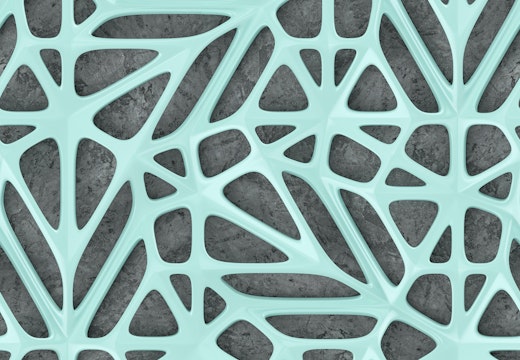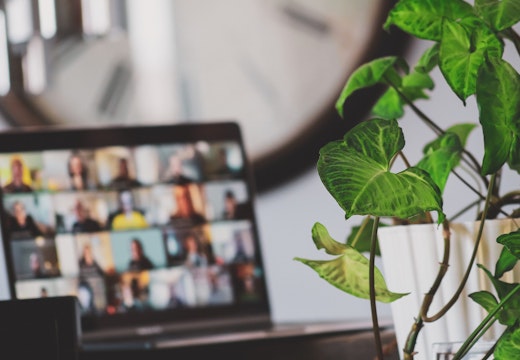People-centric placemaking: designing for psychological safety
Designing for wellbeing means putting people before infrastructure. In the final article in our series with design firm Adrianse on health and work, we explore the benefits of creating a sense of place and belonging
In any discussion of how work and workplace can interrelate more deeply with human health, there is one design factor that underpins all others. This is placemaking, a term taken from the field of urban planning and design, which refers to the creative process of making a space meaningful and significant to the people who utilise it.
Jayanth Gopal, architect and director of global design firm Adrianse, explains, ‘Placemaking is the creation of significance. With this approach we ask, what is it like to live or work in this space? Placemaking is defined by the distinction between space and place – the word “place” gives us a sense of human surroundings, it’s not just any other cold and unrelatable space, there is a feeling of connection about a place that is undeniable and personal.’
A strong ‘sense of place’ can positively influence wellbeing in the workplace, adds fellow Adrianse director Chinmayee Ananth. ‘It’s all about putting people ahead of infrastructure. It brings physical, mental and spiritual health all together.’
Spatial systems
This is the final piece in our article series considering the multi-faceted relationship between health and work – a collaboration between WORKTECH Academy and Adrianse, which seeks to explore new insights and connections. Adrianse has 11 international studios from New York and Milan to Singapore, Sydney and Bangalore, and notably strong roots in India and Singapore; it brings a wealth of experience in designing and building workspaces, healthcare environments and data centres.
In this series, we have introduced the subject calling for deeper engagement between health and work (see Article 1), discussed the impact on wellbeing of technology systems in enabling hybrid work (see Article 2), explored the rise of biomorphism and the influence of natural systems in the workplace (see Article 3), and argued for a more comprehensive approach to inclusion with cultural systems that build wellbeing through respect and belonging (see Article 4).
Having shared ideas on the cultural systems, natural systems and technology systems that help to create a workplace that truly prioritises health, it is the turn of spatial systems to be examined in this final article. Placemaking is the foundation on which everything else can be built. In the words of Chinmayee Ananth, ‘It goes right to the fundamentals of health. Do you feel at home in this place? Is your mind, heart and soul at peace with what’s around you?’
Psychological safety
That feeling of being at home relates to a sense of psychological safety that all employees strive to feel within a space. It is a unique blend of culture and organisational approach, supported by design. The Harvard Business Review uses the phrase team psychological safety, a term coined by Professor Amy Edmondson, to describe ‘a shared belief held by members of a team that it’s okay to take risks, to express their ideas and concerns, to speak up with questions, and to admit mistakes — all without fear of negative consequences’.
Employees that feel psychological safety have the support for their physical, mental and cultural wellbeing that they need in order to thrive and undergo a process of continuous learning. This is perhaps the ultimate aim of workplaces that engage with design for health.
As Jayanth Gopal states ‘if you feel at home, you are more likely to innovate – to think outside the box and to feel comfortable enough to “fail fast” and learn from your mistakes. Instead of fostering a fear-based environment, companies can create a space where you are empowered and energised to do your best work.’
Designing for holistic health
At Adrianse, placemaking is both an integral and foundational part of thinking more profoundly about the creation of healthy work environments. Working with global IT firm RedHat to build its new Singapore headquarters, Adrianse showcased how placemaking could be used as the basis to achieve a sense of psychological safety for all employees, through the inclusion of biomorphic design, design for cultural inclusivity and flexible working processes. The 65,000 sq ft RedHat project, designed and built in 2022 for 360 staff, embodies Adrianse’s commitment to build a deeper interconnectedness between work and health.
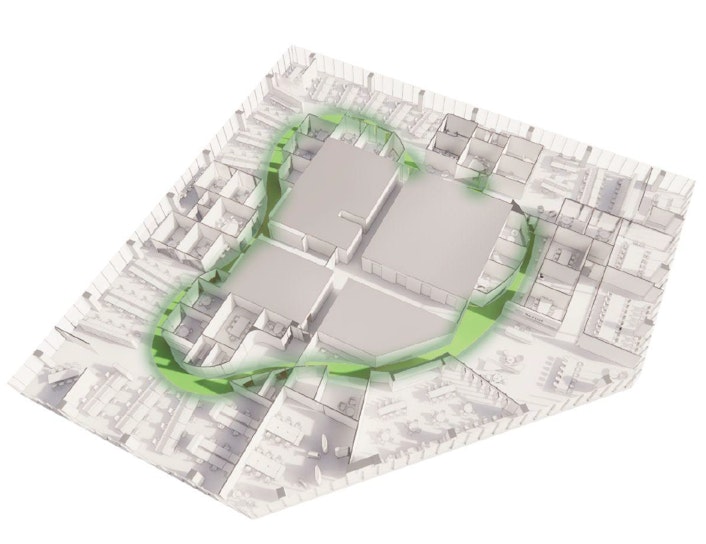
Floor plan for RedHat showing curved corridor within this innovative office space which mimics the pathways found in serene parks and green zones of Singapore.
A key business requirement was to design a RedHat workplace that would bring a diverse group of people from different parts of the world back to the office. Health was not explicit in the brief but underpinned the aim to create a warm welcome back and support a healthier, happier workforce. The design strategy was based on devising a ‘city plan’ heavily connected to Singapore as a place: there are green spaces, outdoor spaces, interior ‘walks’, and the best external views from the floorplate are open to everyone. There is a dualism and complementarity between what is intrinsic to RedHat and what is an expression of the city around it.
Jayanth Gopal explains: ‘The meandering path as a spatial system that weaves through the floorplate is a very distinctive design element of the RedHat plan. It creates opportunities for connection and makes the interior relatable and scalable. Like an urban park, it creates moments that encourage people to get up from the desk and do a lap of the office.’
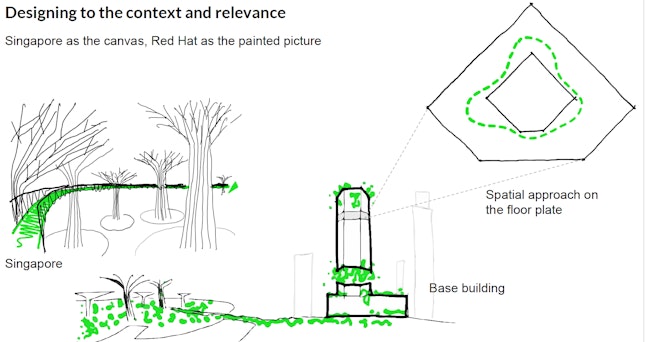
Image: concept sketch courtesy of Adrianse
Chinmayee Ananth adds: ‘RedHat is a combination of culture, biomorphism and diverse thinking, the acknowledgment of a need to be sensitive to different kinds of mindset as well as different accessibility needs, roles and perspectives.’
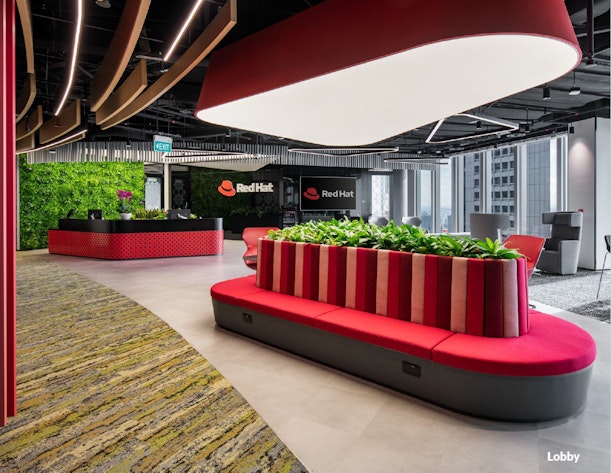
Image: RedHat lobby courtesy of Adrianse
Workplace transformation
To build effective and healthy spatial systems, placemaking needs to integrate a range of other workplace systems: inclusive cultural systems, healing and restorative natural systems, and supportive technology systems that allow for flexibility of choice. Through the lens of placemaking, these strands of development can be brought together to facilitate the transformation of the workplace towards a position where the environment that employees work in actively enhances their health, instead of impacting it negatively.
However, work today is more than just an office. To think more connectedly about how we can offer healthier work and healthier workplaces, we must return to the scale of the city and think more about the cross-pollination of different sectors and spaces. Jayanth Gopal emphasises the importance of a cross-sector approach, arguing that ‘the pandemic has shaken up our design typologies and shaken us out of our comfort zones. Offices have changed, homes have been reconfigured and hospitals have become frontline workplaces’.
‘The pandemic has shaken up our design typologies and shaken us out of our comfort zones…’
Gopal adds: ‘As an organisation that works across typologies, Adrianse is rich with questions as we cross pollinate ideas through different industries – there is an increased openness and interconnectedness through our working styles that allows us to draw ideas from our workspace designs through to our design of healthcare environments and vice versa. This helps us design healthier, happier workplaces across the board.’
Chinmayee Ananth concludes: ‘If we believe in thinking more deeply and conceptually about how healthy work can be defined from multiple perspectives, then it’s important to have those perspectives on which to draw.’



